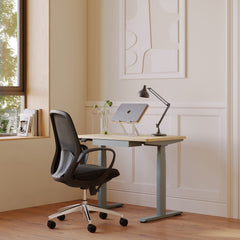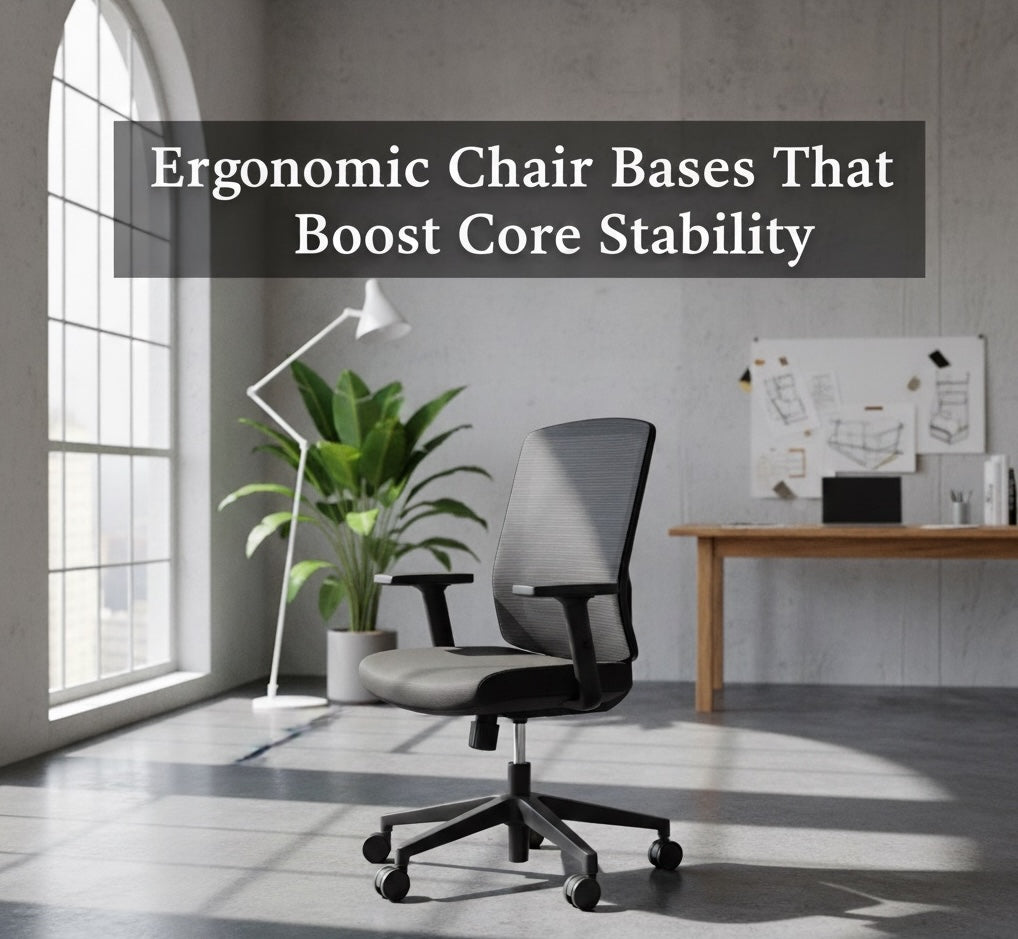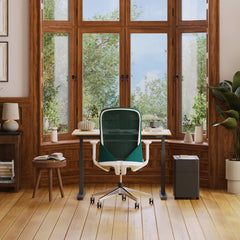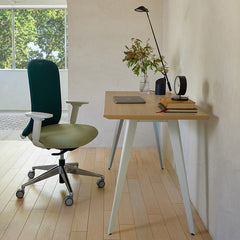Get 10% off your first order
Find the office furniture that’s designed to match your style, comfort, and needs perfectly. Subscribe
Space Shift: The Art of the Live-Work Fusion

Visit quiz page to see how we makes it easy to create an inspiring workplace


A strong core is not only useful for athletic movement. It is the stabilizing system that helps the spine stack neutrally during seated tasks, supports breathing mechanics, and shares load between the pelvis, trunk, and rib cage. When the base of a chair invites subtle balance corrections, the abdominal wall, multifidus, pelvic floor, and obliques coordinate to steady the torso. This quiet, continuous activity prevents the slow collapse into slouching that stresses discs and ligaments.
Research-driven ergonomics emphasizes reducing awkward postures and static loading. Credible overviews such as the CDC insights on workplace ergonomics and musculoskeletal health explain how better fit and task alignment lower risk for discomfort. Translating that guidance to seating means selecting chair bases that encourage gentle motion while protecting spinal alignment.
When you sit on a surface that allows micro motion, mechanoreceptors in the hips and lower back cue the nervous system to make small corrections. The transverse abdominis tightens to create abdominal pressure, the multifidus provides segmental control, and the obliques steer rotational balance. None of this should feel like a workout. The effect is similar to standing on a very stable surface that still lets the ankles and hips remain awake.
Three linked elements determine whether a chair supports core stability:
Base mechanics that allow modest degrees of controlled movement.
Spinal orientation that remains close to neutral during those movements.
Seat responsiveness that distributes pressure and does not force the pelvis into a posterior tilt.
Together, these elements transform sitting from a passive posture into a low effort, self-correcting position.
Traditional chair bases were built primarily for immobility. That approach maximizes short term stillness, yet it can reduce muscle activity and circulation during longer sessions. Modern bases use tilt geometry, elastomer interfaces, and bearing placement to introduce safe, repeatable motion arcs. The goal is not to wobble freely but to support small, predictable shifts that keep the torso organized.
Active sitting does not mean constant fidgeting. It means the base allows a few degrees of movement in multiple directions, so the pelvis can make small adjustments as you type, turn, or reach. These tiny shifts provide periodic decompression for the discs, promote blood flow, and keep the postural muscles responsive. The sensation should be calm and centered rather than unstable.
| Chair Base Design | Movement Style | Muscle Engagement | Best Use Case | Comfort Stability |
|---|---|---|---|---|
| Fixed star base | Static, minimal play | Low | Short, simple tasks | Firm and steady |
| Tilt mechanism base | Controlled forward and backward arc | Moderate | General office work | Balanced and predictable |
| Free motion base | Multi directional micro shifts | High | Active work setups and long sessions | Dynamic but supportive |
Each mechanism has a place. Fixed bases suit short tasks or frequent movers who do not sit long. Tilt mechanisms suit mixed duties that benefit from predictable control. Multi directional bases support users who want subtle movement throughout the day without losing a sense of grounding.
Specific models illustrate how base geometry influences comfort. The emphasis below is on how each base behaves and which user goals it serves.
The adaptive ergonomic chair base with synchronized lumbar tilt provides a responsive arc that tracks pelvic movement and supports the lumbar curve as you recline or return to upright. This coordination reduces the common gap between the backrest and lower spine, so the core does not need to fight to regain neutral after small position changes.
Design and ideation often include reaching, sketching, and turning to collaborate. The dynamic base engineered for creative movement supports subtle lateral transitions, encouraging trunk rotation control without forcing the body into rigid alignments. The effect is fluid, which suits workflows that involve frequent side to side engagement.
Knowledge workers who remain focused for extended periods often need movement that feels very orderly. The hybrid tilt system for balance and endurance blends a clear pivot path with adjustable resistance. Users can tune it to achieve gentle motion while preserving a centered feel that supports typing accuracy and visual tasks.
Collaborative spaces and compact rooms benefit from chairs that transition gracefully between tasks. The sculpted ergonomic base that encourages natural movement employs a refined form that allows light micro motion, so posture changes do not feel abrupt. The result is an easy transition between short discussions, note taking, and focused moments.
To understand why base design matters, consider how the pelvis guides the spine. A base that permits small anterior and posterior tilts lets the sacrum align with the natural lumbar curve. When that curve is preserved, thoracic and cervical segments stack more effortlessly. This stack decreases shear forces and muscle guarding in the shoulders and neck.
Breathing and posture are linked. In a neutral pelvic position, the diaphragm and pelvic floor coordinate efficiently. A base that allows small corrective tilts helps maintain that coordination. The result is steadier breathing rhythms that support focus without conscious effort.
Prolonged compression in one posture reduces the exchange of nutrients in intervertebral discs and soft tissues. Gentle motion changes pressure patterns over time, which supports tissue hydration and comfort. Chairs that encourage these modest variations help users feel fresher across long sessions.
Setup has a greater impact on comfort than most people realize. Even high quality bases cannot compensate for poor alignment. Use the sequence below to tune the base and surrounding workstation.
1. Seat height. Set height so hips are slightly above knees. This encourages a mild anterior pelvic tilt.
2. Base tension. Increase or decrease tilt resistance until returning to upright feels smooth rather than abrupt.
3. Backrest contact. Adjust depth so the lumbar area touches the backrest during small movements.
4. Arm support. Set armrests to remove downward load from the shoulders, not to prop you upright.
5. Foot support. Keep feet flat on the floor. If the desk is high, use a compact footrest for contact.
6. Screen position. Align the top of the monitor near eye level to reduce neck strain.
7. Activity check. Type for two minutes and notice whether you feel small, natural corrections rather than an urge to brace.
Deep writing. Use slightly higher tilt resistance to feel stable while typing, but allow a small forward return.
Reading or reviewing. Reduce resistance a touch so reclining to scan text feels easy.
Collaboration at the desk. Favor more lateral freedom so turning does not pull you forward.
A base that supports micro motion performs best when the whole workstation respects human movement. Alternating posture is particularly helpful.
Use a height adjustable surface to vary your stance through the day. A compact option like a compact sit-stand desk for active posture cycling allows a simple change in height so you can continue your task with minimal interruption. Alternate when you notice fidgeting or the urge to shift. The goal is steady circulation and joint variety, not maximal time at either posture.
Small tools can support the chain of alignment from feet to pelvis. Cushioned footrests reduce pressure and encourage ankle motion. Simple balance boards used periodically can wake up lower limb stabilizers. Curate these additions intentionally rather than filling the space with gadgets.
Different users have distinct movement patterns. Match base behavior to your daily tasks and space constraints.
Analytical work with long focus blocks. Choose predictable tilt with adjustable resistance. This supports a centered feel that protects posture during typing.
Creative and collaborative work. Favor bases that allow gentle lateral motion and rotation. The goal is support that moves with the body during frequent position changes.
Compact rooms or shared areas. Lightweight, responsive bases that are easy to reposition are more practical than heavy mechanisms.
Signals that your current chair may not support core stability include persistent lower back tightness after sitting, difficulty maintaining an upright posture even with effort, and shoulders that creep upward as you type. Explore the ergonomic seating lineup designed for balance and posture health to compare base behaviors that align with your needs.
Thoughtful accessories can complete the movement picture without overwhelming the workspace.
Footrests to maintain stable contact and reduce leg tension.
Simple lumbar cushions for users with flat lumbar curves, applied sparingly so they do not force excessive arch.
Occasional use balance tools to wake up ankles and hips during short breaks.
For curated add ons that complement motion friendly bases, see ergonomic desk accessories that improve seated balance. Consistency matters more than quantity. Choose a few items that you will actually use.
Two or three micro breaks each hour can be enough. Stand to take a call, perform a gentle side to side hip shift, or align the spine with a tall sit for a minute. These small actions reinforce what the base is already encouraging.
You can assess a chair’s base behavior without lab equipment. The methods below provide a realistic check of alignment and comfort.
Reach test. Reach forward to a distant key or pen. A supportive base will allow the pelvis to tilt without pulling the low back into strain.
Turn test. Rotate to speak with a colleague. A responsive base will let your trunk follow the motion smoothly while your feet stay planted.
Return to neutral test. After a recline, release to upright. You should feel a calm return rather than a snap.
Fewer episodes of repositioning to escape pressure spots.
Easier breathing with a more open chest position.
Less neck or shoulder tightness by late afternoon.
Record what you feel at the same time each day. If you notice creeping slump, add a small bump of tilt resistance and raise the seat a few millimeters. If you feel held back during collaboration, reduce resistance slightly to allow more lateral ease.
Ergonomic performance depends on consistent function. Keep the base clean and free of debris, especially around casters and pivot points. Inspect fasteners periodically so the geometry remains true. Replace worn casters to maintain smooth rolling that does not fight alignment. These basic steps protect the motion characteristics that support your core.
Myth. More movement is always better.
Reality. Excessive mobility can feel unstable. The goal is controlled motion that preserves alignment.
Myth. Firm, static bases protect the back by holding the body still.
Reality. Prolonged stillness can increase stiffness. Predictable micro motion helps distribute load.
Myth. One ideal base suits everyone.
Reality. Work style, body shape, and room layout influence which mechanism feels natural.
Heads down analyst in a quiet office. Needed steadiness with modest recline. A controlled tilt base with medium resistance improved typing comfort and reduced afternoon neck tension.
Product designer in a studio. Needed fluid lateral shifts. A multi directional base supported sketching and collaboration without chasing the seat position.
Hybrid worker in a compact apartment. Needed simple adjustability and easy repositioning. A lightweight, responsive base improved posture consistency during short sprints of focused work.
Long form tasks benefit from predictable cycles. Consider this sample rhythm:
Begin with upright sitting for focused writing.
Shift to a light recline for reading or review.
Stand for five to ten minutes while planning or editing.
Return to sitting with slightly reduced resistance for collaboration or calls.
Use a height agile surface such as a compact sit-stand desk for active posture cycling to keep transitions smooth. The point is to keep tissue loading varied while staying productive.
Keep evaluation criteria practical and specific. Look for the following:
Range and feel of movement. Test whether the arc supports your tasks without feeling floaty.
Adjustment clarity. Controls should be intuitive so you can change resistance or height quickly.
Seat and back synergy. The backrest should maintain contact through small movements.
Foot stability. Your feet should remain planted during common reaches and turns.
Fit within space. Ensure the base footprint suits the room and allows free movement.
Avoid relying on single headline features. Real comfort comes from a set of characteristics that work together during your actual tasks.
Open plan collaboration. Favor chairs that roll smoothly and allow side to side ease so you can engage with teammates without twisting uncomfortably.
Home office with limited depth. Consider bases that offer micro motion in a compact footprint and pair them with a shallow desk to maintain knee clearance.
Hot desking or shared seating. Choose models with clearly labeled controls and durable mechanisms so adjustments remain consistent across users.
The benefits that count are straightforward. Users commonly notice fewer pressure points, less end of day stiffness, steadier focus during long writing sessions, and easier breathing when seated tall. These are practical markers that your chair base and setup are supporting the core rather than asking it to fight the furniture.
Align your seating choice with related tools from the same ecosystem when possible. Coordinated design language often means predictable adjustment behavior. If you want a consistent approach across spaces or roles, evaluate a family of models side by side:
The controlled arc of the adaptive ergonomic chair base with synchronized lumbar tilt suits steady office tasks that still benefit from movement.
The lateral ease of the dynamic base engineered for creative movement suits studios and brainstorming zones.
The balanced precision of the hybrid tilt system for balance and endurance supports long focus blocks with calm motion.
The responsive lightness of the sculpted ergonomic base that encourages natural movement fits compact or collaborative rooms.
For a broader survey across models and finishes, compare the ergonomic seating lineup designed for balance and posture health. Pair your choice with focused tools from ergonomic desk accessories that improve seated balance to complete the setup.
| Adjustment | Practical Outcome | How to Test Quickly |
|---|---|---|
| Increase tilt resistance | More centered feel during typing | Type for two minutes and check if shoulders stay relaxed |
| Decrease tilt resistance | Easier recline for reading or calls | Lean back and see if return to upright feels smooth |
| Raise seat height | Encourages mild forward pelvic tilt | Check that hips sit slightly above knees |
| Lower seat height | Increases foot contact and stability | Confirm feet are flat without toe reach |
| Move backrest closer | Maintains lumbar contact during micro motion | Reach forward and verify back support remains present |
This table aligns adjustments with outcomes you can verify immediately. Use it to fine tune the balance between movement and steadiness.
Neutral spine. Natural curves of the cervical, thoracic, and lumbar regions when stacked without strain.
Anterior pelvic tilt. Mild forward rotation of the pelvis that supports the lumbar curve in sitting.
Tilt resistance. The force required to recline or return to upright on a pivoting base.
Multi directional base. A mechanism that allows small movements in several planes rather than a single pivot path.
Segmental control. Stabilization provided by deep back muscles that guide individual vertebral segments.
A supportive chair base does not need to feel complicated. It should provide controlled freedom to move, clear adjustments, and stable contact points for the feet and back. Pair it with a workstation that welcomes posture variety. Use practical tests to confirm alignment and comfort. Maintain the mechanism so motion remains smooth. These grounded steps help the chair work with your core to deliver steady posture, better breathing mechanics, and sustainable comfort over time.

Space Shift: The Art of the Live-Work Fusion

How to Arrange Furniture to Maximize Peace

Crafting Calm: Your Guide to the Perfect Reading Corner
Get 10% off your first order
Find the office furniture that’s designed to match your style, comfort, and needs perfectly. Subscribe
Leave a comment